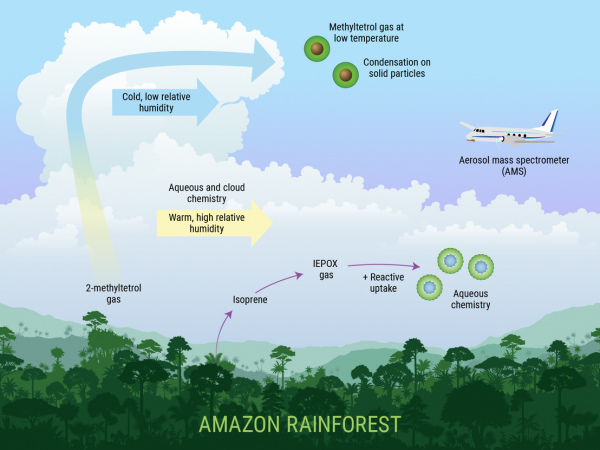Researcher Uses EMSL Computing Capabilities to Discover Atmospheric Process over Amazon Rainforest
Team’s findings significant in study of climate change

Researchers used supercomputing resources at the Environmental Molecular Sciences Laboratory to reveal and model a previously unrecognized atmospheric process that creates a key type of fine particles over the Amazon rainforest. The findings have important implications in the study and development of solutions for climate change.
The type of fine particles, known as isoprene epoxydiol secondary organic aerosols (IEPOX-SOAs), along with other fine particles, helps cool the planet by reducing the amount of sunlight reaching the Earth, said Manish Shrivastava, an Earth scientist at Pacific Northwest National Laboratory (PNNL). The particles also seed clouds that affect precipitation and the water cycle, he said.

Shrivastava and his team were examining the formation processes of IEPOX-SOAs measured by scientific aircraft when they discovered a large disparity between the measurements of the particle and its mass loadings predicted by traditional atmospheric models. The data was collected by a German aircraft known as the High Altitude and Long Range Research Aircraft (HALO), which is flown up to 14 kilometers in altitude, and a Department of Energy aircraft operated by the Atmospheric Radiation Measurement user facility, which is flown at lower altitudes. Based on traditional model projections, loadings of IEPOX-SOAs should have been at least an order of magnitude lower than what was measured at 10–14-kilometer altitudes, he said.
“The models wouldn’t predict the observed IEPOX-SOA loadings at 10-to-14-kilometer altitudes in the Amazon, and we were getting what I believed to be either model failures or a lack of understanding of the observations,” Shrivastava said. “I could explain it at the surface but couldn’t explain it at higher altitudes.”
The team set out to find the reason by integrating modeling and measurements.
Plant-derived, semi-volatile gas as key component in discovery
Before Shrivastava’s and his team’s research, it was believed that IEPOX-SOAs were formed primarily by multiphase atmospheric chemistry pathways. The issue with this assumption, however, is that these pathways do not occur in the upper troposphere because of its extremely cold and dry conditions. To figure out the reason for the disparity, the team combined specialized high-altitude aircraft measurements and detailed regional model simulations conducted using supercomputing resources at EMSL, which helped reveal an undiscovered component of the atmospheric processes.
The team identified that a semi-volatile gas known as 2-methyltetrol, which can be formed by in-plant oxidation processes and by oxidation of IEPOX gases deposited on the surfaces of leaves and soils, is transported by strong cloud updrafts into the cold upper troposphere. This gas then condenses at cold temperatures to form fine particles that are detected as IEPOX-SOAs by the aircraft. This finding therefore explains the loadings of IEPOX-SOAs observed at high altitudes and adds a new process in the model that now accurately predicts the formation of IEPOX-SOAs at high altitudes.
“This is certainly an important discovery because it aids in our understanding of how these fine particles are formed, and therefore, shines a new light on how natural processes in the forest cool the planet and contribute to clouds and precipitation,” Shrivastava said. “Along with a changing global climate and rapid deforestation in many parts of the Amazon, humans are perturbing the key natural processes that make fine particles in the atmosphere and modulate global warming.”

Scratching the surface
Shrivastava said with their newfound discovery of the atmospheric process, they still have lots to study and explore. The newly identified process from plants, he said, could explain a broad array of atmospheric particle phenomena over other forested locations across the world, in addition to the Amazon rainforest.
“The tropical Amazon rainforest constitutes the lungs of the Earth, and this study connects natural processes in the forest to aerosols, clouds, and the Earth’s radiative balance in ways that have not been previously recognized,” he said. “But this is just the beginning of what we know and will open new frontiers of research in land–atmosphere–aerosol–cloud interactions. Understanding how the forest produces these particles could help us understand how rapid deforestation and changing climate will affect global warming and the water cycle.”
The team’s findings were published recently in ACS Earth and Space Chemistry.

